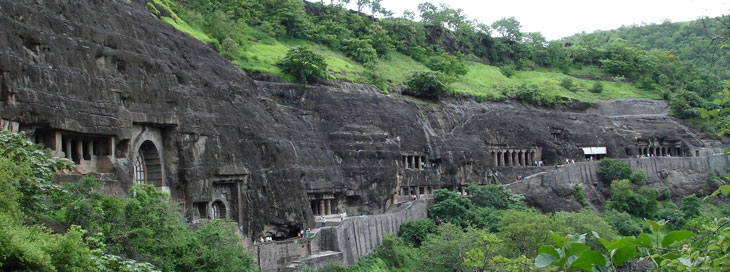Mumbai Tourism

Mumbai general info
| Area | 600 sq. km. |
| Altitude | Sea level. |
| Temperature | Summer : Max 33.3ºC, Min 22.7ºC. Winter : Max 29.5ºC, Min 19.4ºC. |
| Rainfall | 254 cms annual. |
| Languages | Marathi, Hindi, and English. |
Mumbai introduction
The city of Bombay was officially renamed Mumbai in January 1996. The mumbaites believe that this name came from the goddess 'Mumbai', worshipped by the original Koli inhabitants. When the Portuguese arrived they called the harbour Bombaim, which may have stemmed from 'buan bahia', meaning 'good bay' in Portuguese, or was a corruption of the original Koli name.
Despite poverty and eye-watering pollution, it is so dynamic that paupers still flock there in hopes of becoming successful entrepreneurs. Mumbai is the stronghold of the Indian film industry. Throughout the year Western and Indian music concerts and festivals and Indian dance shows are performed in Bombay. , Mumbai is the industrial hub of everything from textiles to petrochemicals, and responsible for half of India's foreign trade.
Mumbai history
The city of Bombay originally consisted of seven islands called Colaba, Mazagaon, Old Woman's Island, Wadala, Mahim, Parel, and Matunga-Sion. This group of islands has been joined together by a series of reclamations, formed part of the kingdom of Ashoka, the famous Emperor of India. Bombay's colonial legacy is the Gateway of India built to commemorate the Royal visit of George V and Queen Mary in 1911. The Taj Mahal hotel opposite the Gateway was built in 1903 by Jamashetji N. Tata, founder of a prestigious industrial house, to counter a ban on Indian entering the then famous Watson's hostelry.
The later half of the 19th century was also to see a feverish construction of buildings in Bombay, many of which such as, the Victoria Terminus, the General Post Office, Municipal Corporation, the Prince of Wales Museum, Rajabai Tower and Bombay University, Elphinstone College and the Cawasji Jehangir Hall, the Crawford Market, the Old Secretariat (Old Customs House) and the Public Works Department (PWD) Building, still stand today as major landmarks. The Gateway of India was built to commemorate the visit of king George V and Queen Mary for the Darbar at Delhi in 1911. The historic session of the All India Congress Committee began on the 7th of August 1942.
Its venue was the Gowalia Tank Maidan, where the congress was born in 1885. It was at this session that the "Quit India" call was given by Mahatma Gandhi and other Indian National Congress leaders. After independence the Congress party led by Jawaharlal Nehru at the Center was swept to power in most of the Indian States, which were constituted on the basis of language spoken by the majority of its people. The Bombay State included the city as its seat of government. In 1960 the state of Bombay was split into Maharashtra and Gujarat states again on linguistic basis, the former retaining Bombay city as its capital.
Mumbai fair & festivals
The Ganesh Chaturthi :- Ganesha is the god of wisdom and prosperity and is invoked before the beginning of any auspicious work by the Hindus. According to mythology he is the son of Shiva and Parvati, brother of Kartikeya. Ganesha is the munificent god of wisdom and Ganesh Chaturthi is celebrated in his honour and in the states of Maharashtra, Tamil Nadu, Karnataka and Andhra Pradesh and many other parts of India. In Bombay alone, more than 6000 Ganesha statues are commissioned collectively by factories.
Upto 10 metres in height these statues are carried on decorated floats. Little Ganesha's are placed in nukkad or street corners and in homes, and poojas are performed daily. The festival is so popular that in Mumbai the preparations begin months in advance. Images of Ganesha are installed and elaborate arrangements are made for lighting and decoration, and celebrations are on for 7-10 days. The Chaturthi is the last day dedicated to the elephant-headed god, and thousands of processions converge on the beaches of Mumbai to immerse the holy idols in the sea. This immersion is accompanied by drum- beats, devotional songs and dancing.
Gudi Padava :- It is a day of great festivity and rejoicing. People get up early and clean their houses, decorating them with intricate rangoli designs. A silk cloth is tied to a pole with a brass goblet or kalash atop it, which is supposed to drive away evil from the house. This is raised aloft and worshipped. The Maharashtrian New Year's Day is celebrated in March/April, on the first day of Chaitra.
Mumbai best season
The climate of Bombay, according to the traders, was so unhealthy. The weather is extremely hot from March to May. The rainy season, brought mostly from monsoon winds from the southwest, last from June to September and is followed by the post-monsoon season, which last from october to November, hen the weather is hot again. Best time to visit November until March; April until mid June hot followed by monsoon until end of September.